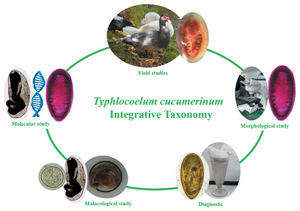Crossref Citations
This article has been cited by the following publications. This list is generated based on data provided by
Crossref.
Assis, Jordana Costa Alves de
Pulido-Murillo, Eduardo
Melo, Alan Lane de
Martins, Nelson Rodrigo da Silva
and
Pinto, Hudson Alves
2022.
Philophthalmus gralli in domestic waterfowl: An environmental study in an urban area from Brazil.
Veterinary Parasitology: Regional Studies and Reports,
Vol. 29,
Issue. ,
p.
100701.
López-Hernández, Danimar
Valadão, Marisa Caixeta
de Melo, Alan Lane
Tkach, Vasyl V.
Pinto, Hudson Alves
and
ZHANG, Feng
2023.
Elucidating the life cycle of opossum parasites: DNA sequences reveal the involvement of planorbid snails as intermediate hosts of Rhopalias spp. (Trematoda: Echinostomatidae) in Brazil.
PLOS ONE,
Vol. 18,
Issue. 3,
p.
e0279268.
Dutton, Haley R.
Bullard, Stephen A.
and
Kelly, Anita M.
2023.
New Genus and Species of Cyclocoelidae Stossich, 1902 (Platyhelminthes: Digenea) Infecting the Nasopharyngeal Cavity of Canada Goose, Branta canadensis (Anseriformes: Anatidae) from Western Alabama.
Journal of Parasitology,
Vol. 109,
Issue. 4,
Assis, Jordana C. A.
and
Pinto, Hudson A.
2023.
Biomphalaria straminea as an Intermediate Host of a Renal Trematode Species of the Genus Tanaisia (Trematoda: Eucotylidae) in Brazil.
Acta Parasitologica,
Vol. 68,
Issue. 1,
p.
282.
Kirillov, Alexander A.
Kirillova, Nadezhda Yu.
Shchenkov, Sergei V.
Knyazev, Alexei E.
and
Vekhnik, Victoria A.
2024.
The Morphological and Molecular Characterization of the Avian Trematodes Harrahium obscurum and Morishitium dollfusi (Digenea: Cyclocoelidae) from the Middle Volga Region (European Russia).
Biology,
Vol. 13,
Issue. 8,
p.
621.
Goodman, Michele
and
Higbie, Christine T.
2024.
Neonatal Care of Anseriformes.
Veterinary Clinics of North America: Exotic Animal Practice,
Vol. 27,
Issue. 2,
p.
313.
Vainutis, Konstantin S.
Voronova, Anastasia N.
Andreev, Mark E.
and
Shchelkanov, Mikhail Yu.
2024.
New insights into the systematics of Cyclocoelidae (Trematoda: Echinostomatoidea) based on novel morphological and molecular data, with description of a new species and a new genus.
Systematic Parasitology,
Vol. 101,
Issue. 6,
Cajiao-Mora, Kamila
Brule, John H.
Dutton, Haley R.
and
Bullard, Stephen A.
2024.
Supplemental Description of Caballerotrema annulatum (Diesing, 1850) Ostrowski de Núñez and Sattmann, 2002 (Digenea: Caballerotrematidae) from a New Host (Electrophorus Cf. Varii) and Locality (Amazon River, Colombia) with Phylogenetic Analysis and Emended Generic Diagnosis.
Journal of Parasitology,
Vol. 110,
Issue. 4,
Assis, Jordana Costa Alves de
and
Pinto, Hudson Alves
2024.
The Natural Infection of Freshwater Snails with the Avian Air Sac Fluke, Cyclocoelum mutabile (Trematoda: Cyclocoelidae), in Brazil.
Diversity,
Vol. 16,
Issue. 7,
p.
422.
Huston, D.C.
Cutmore, S.C.
and
Cribb, T.H.
2025.
Digenean life cycle truncation has enabled the opportunistic exploitation of herbivorous fishes.
Journal of Helminthology,
Vol. 99,
Issue. ,
Martinez, Lorena E.
Gilardoni, Carmen M.A.
Medina, Cintia D.
Quintana, Silvina
Martín, Pablo R.
Cremonte, Florencia
and
Etchegoin, Jorge A.
2025.
Intramolluscan stages of digeneans parasitizing the pest apple snail Pomacea canaliculata from Argentina: Molecular identification and histopathology.
Journal of Invertebrate Pathology,
Vol. 209,
Issue. ,
p.
108271.
